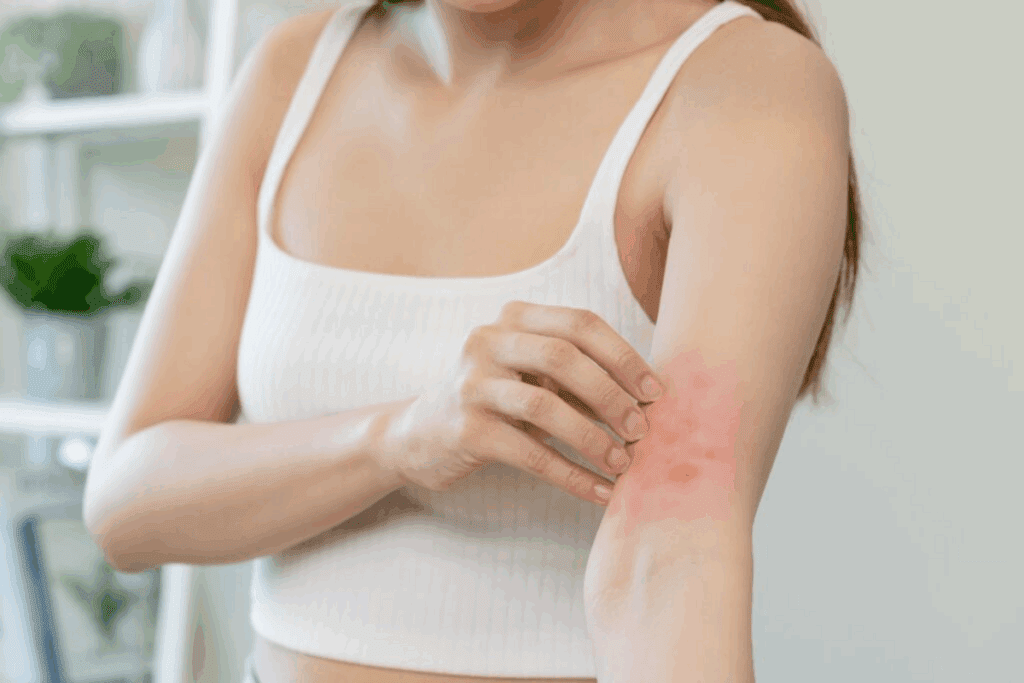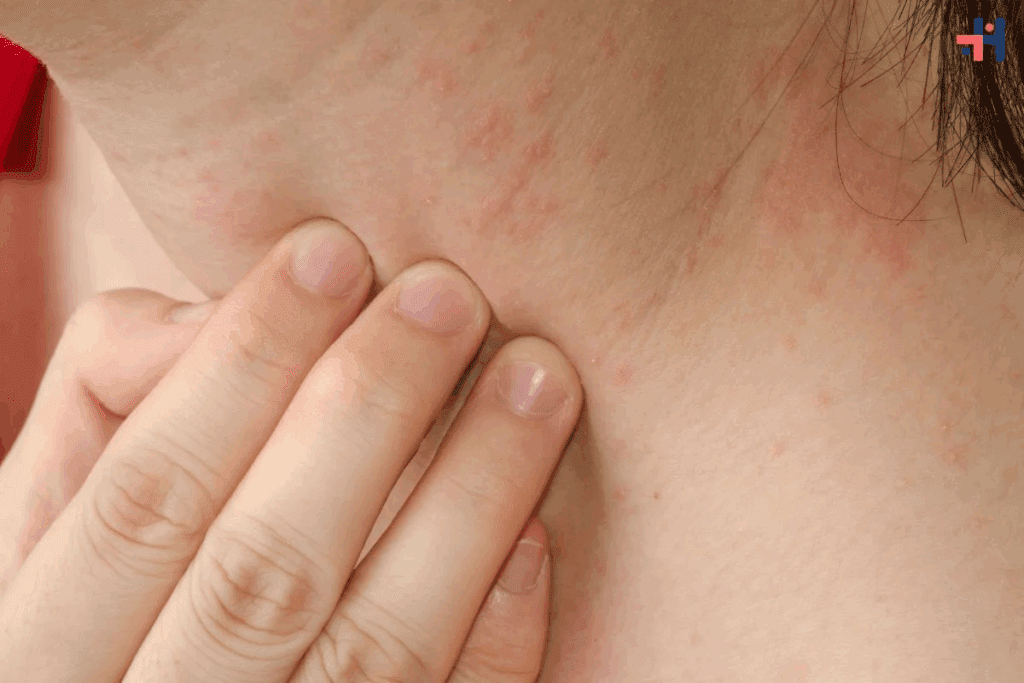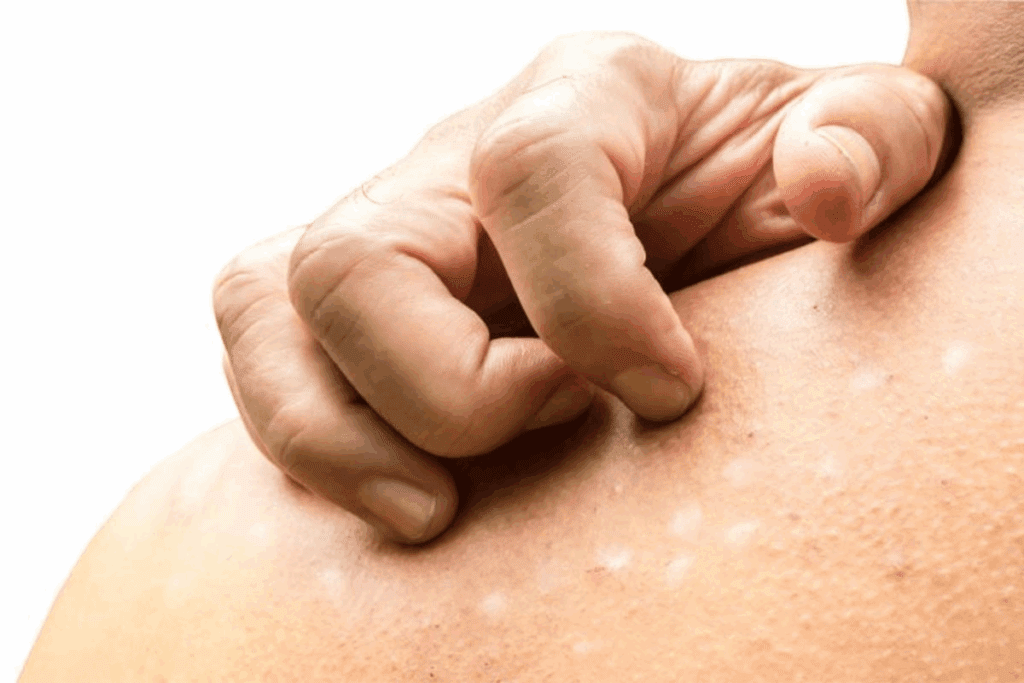Last Updated on November 20, 2025 by Ugurkan Demir

Itchy skin conditions can really bother you. We’ll look at why your skin might itch and bruise. We’ll also share quick tips to help you feel better.Discover itchy skin rash and bruising causes, with quick facts and tips to identify underlying health issues.
Things like eczema or dermatitis can make your skin itch. Sometimes, itchy skin hints at bigger health issues, like kidney or liver problems. Knowing what’s causing it is key to fixing it. For more info on itchy skin, check out healthdirect.gov.au.

It’s important to know how itchy skin rash and bruising are linked. Many skin problems can make your skin itch, like dermatitis, eczema, psoriasis, and allergies. If you also see bruises, it might mean there’s a bigger health issue.
Itchy skin rash and bruising can be connected in different ways. For example, some autoimmune diseases can cause both symptoms. This happens when the immune system attacks healthy skin cells, causing inflammation and bruises.
Another link is through blood vessel problems. Issues with blood vessels can lead to bruising and sometimes itchiness. This is because of poor circulation or inflammation.
Common Causes:
It’s key to know the signs of itchy skin rash and bruising. This helps in getting early treatment. Some signs to watch for include:
| Symptom | Description | Potential Cause |
| Severe itching | Persistent and intense itching sensation | Allergic reaction, eczema |
| Large bruises | Significant bruising without clear trauma | Blood disorder, vascular issue |
| Rash spread | Rash spreading across the body | Infection, autoimmune disorder |
“Early recognition of the symptoms and understanding their connection can significantly improve treatment outcomes.” – Medical Expert
Knowing how itchy skin rash and bruising are connected helps you get the right medical care. This can stop more serious health problems from getting worse.

Allergic reactions are a common cause of itchy skin rashes and bruising. They happen when the body’s immune system reacts to substances it doesn’t like. These substances are called allergens.
There are different types of allergic skin responses. These include contact dermatitis, urticaria (hives), and angioedema. Contact dermatitis happens when the skin touches something it’s allergic to. It can cause redness, itching, and sometimes blisters.
Hives, or urticaria, are itchy welts that can pop up anywhere on the body. Angioedema is a deeper swelling that can happen with hives. It’s serious if it makes it hard to breathe.
Knowing some quick facts about allergic skin reactions can help you deal with them. Here are a few important points:
Managing skin issues caused by allergies involves a few steps. You can avoid allergens, use special skin care, and sometimes see a doctor. Here’s how:
Autoimmune conditions often show up as skin problems, like rashes and bruising. This happens because the body’s immune system attacks healthy skin cells by mistake. Knowing about these conditions is key to managing and treating them well.
Autoimmune disorders can harm the skin by causing inflammation and damage. For example, in psoriasis, the immune system makes skin cells grow too fast, causing thick, scaly patches. Lupus can also lead to rashes and make the skin sensitive to sunlight.
Inflammation plays a big role in skin symptoms from autoimmune disorders. It can cause redness, swelling, and itching. This makes the skin more likely to get rashes and bruises.
Several autoimmune disorders can really affect the skin. These include:
Managing autoimmune skin problems needs a full plan. Topical treatments, like corticosteroids, can help with inflammation and itching. For serious cases, medicines that calm down the immune system might be needed.
Changing your lifestyle, like avoiding triggers and eating well, is also important. Working with your doctor to create a treatment plan that fits you is essential.
Blood disorders like anemia and leukemia can cause skin issues. These include itching and bruising. These problems affect how blood carries oxygen and nutrients, leading to skin symptoms.
Blood problems can harm skin health by reducing oxygen and nutrient delivery. Anemia, for example, can make skin pale, itchy, and more prone to bruising. Understanding the link between blood health and skin symptoms is key for early detection and management.
Many blood disorders cause skin symptoms. Some common ones include:
Spotting these conditions early can help manage symptoms and improve outcomes.
Here are some key facts and tips for identifying blood disorders that cause itchy skin rash and bruising:
| Blood Disorder | Skin Symptoms | Recognition Tips |
| Anemia | Pale skin, itchiness | Look for fatigue, weakness |
| Leukemia | Skin rashes, bruising | Watch for fever, weight loss |
| Thrombocytopenia | Easy bruising, bleeding | Check for petechiae, nosebleeds |
Early recognition of these symptoms can lead to timely medical intervention and better health outcomes.
Skin rashes with bruising can come from many sources. These include bacteria, viruses, and fungi. These infections can cause both symptoms, leading to discomfort and worry.
Different infectious agents can cause skin rashes and bruising. Bacteria like Staphylococcus or Streptococcus can cause impetigo or cellulitis. Viruses, such as those causing chickenpox and measles, also lead to rashes. Fungal infections, like ringworm, can cause rashes but bruising is rare.
A medical expert notes, “Infections can cause inflammation and damage to the skin. This can lead to rashes and, in some cases, bruising due to the breakdown of blood vessels near the surface of the skin.”
Infections can cause skin rashes and bruising in several ways. The body’s immune response can lead to inflammation and a rash. In some cases, the infection directly damages the skin, causing both rashes and bruising. For example, septicemia can cause petechiae, small spots on the skin that look like bruising.
| Infection Type | Common Causes | Skin Manifestations |
| Bacterial | Staphylococcus, Streptococcus | Rashes, abscesses, cellulitis |
| Viral | Chickenpox, measles | Rashes, sometimes with bruising |
| Fungal | Ringworm | Rashes, scaling |
To prevent skin rashes and bruising, practice good hygiene. Wash hands often, avoid close contact with sick people, and eat well to boost your immune system. Treating the infection is key, which may include antibiotics, antiviral meds, or antifungal treatments.
Key Prevention Strategies:
Understanding the causes of skin rashes with bruising and taking preventive steps can help. This can reduce risks and improve skin health.
Skin symptoms can be an early warning sign of liver disease. This shows how closely liver health and skin well-being are connected. The liver is key in detoxifying the body and making bile and proteins, affecting the skin.
The liver and skin are closely linked through various physiological processes. When the liver fails, toxins build up in the body, causing skin issues. Liver disease can affect the skin in several ways, including causing itching, jaundice, and rashes.
One main way liver disease impacts the skin is through bile salts buildup. If the liver can’t make or release bile, these salts accumulate in the skin. This leads to intense itching, known as pruritus.
Liver-related skin symptoms can vary widely but often include:
These symptoms can be uncomfortable and may indicate a serious condition. If you’re experiencing any of these, it’s vital to see a healthcare professional.
Maintaining liver health is key to preventing liver-related skin symptoms. Here are some tips to support your liver health:
By following these tips and being mindful of your liver health, you can reduce your risk of liver-related skin symptoms. If you’re concerned about your liver health or are experiencing skin symptoms, consult with a healthcare professional for personalized advice.
Our skin’s health is tied to what we eat. Lack of vitamins like B12 or D can cause skin problems. These issues might include itching and rashes.
Our skin needs many nutrients to stay healthy. Vitamins are key. For example, Vitamin C helps make collagen and protect the skin. Vitamin E fights off damage with its antioxidant powers. Eating foods rich in these vitamins or taking supplements is important for skin health.
Vitamin B12 is vital for making red blood cells and affects the skin. Vitamin D helps skin cells grow and work right. Not having enough of these vitamins can cause skin problems like rashes and itching.
Knowing the signs of vitamin deficiencies in the skin can help find problems early. Look out for:
These signs might mean you’re missing out on vitamins like C, K, or B vitamins. Eating better or taking supplements can help fix these issues.
Eating a balanced diet full of vitamins and minerals is essential for skin health. Include foods like fruits, veggies, whole grains, and lean proteins. For example, eating foods high in antioxidants, like berries and leafy greens, is good for the skin.
| Nutrient | Food Sources | Benefit to Skin |
| Vitamin C | Citrus fruits, strawberries, bell peppers | Boosts collagen production, antioxidant properties |
| Vitamin E | Nuts, seeds, spinach | Protects against oxidative stress |
| Vitamin B12 | Meat, fish, dairy products | Essential for red blood cell production |
At times, supplements are needed to fix vitamin deficiencies. But, always talk to a doctor before starting any supplements to make sure they’re right for you.
Fixing itchy skin rash and bruising starts with finding the cause. Doctors use tests, patient history, and tracking symptoms to figure it out.
Your doctor might run several tests to find the cause. These include:
Get ready for your doctor’s visit by making a list of questions. This will help a lot. Think about these:
Having this info ready can really help your doctor figure out what’s wrong.
Symptom tracking is key to finding the cause of itchy skin rash and bruising. A symptom diary can help you and your doctor see patterns and triggers. Keep track of:
By tracking your symptoms, you give your doctor important clues for diagnosis.
Dealing with itchy skin rash and bruising needs a mix of medical treatments, home remedies, and changes in daily habits. The best plan often uses all these to control symptoms and find the root cause.
Medical treatments are key for itchy skin rash and bruising, mainly for allergies, autoimmune issues, or infections. Common treatments include:
| Condition | Common Medical Interventions |
| Allergic Reactions | Corticosteroids, Antihistamines |
| Autoimmune Disorders | Immunosuppressants, Corticosteroids |
| Infections | Antibiotics, Antivirals |
Along with medical treatments, home remedies can also help with itchy skin rash and bruising. These include:
Changing your lifestyle can greatly help with itchy skin rash and bruising. These changes include:
By mixing medical treatments with home remedies and lifestyle changes, people can better manage itchy skin rash and bruising. This improves their overall quality of life.
To stop itchy rashes and bruises from coming back, we need to do several things. This includes changing our daily habits, making our environment better, and planning for the long term. By doing these things, we can make it less likely for these problems to happen again.
Keeping our skin healthy is key to avoiding itchy rashes and bruises. We can do this by following some simple daily habits. For example:
Changing our environment can also help a lot in preventing itchy rashes and bruises. Here are some things to consider:
| Modification | Benefit |
| Using an air purifier | Reduces allergens and irritants in the air |
| Avoiding extreme temperatures | Prevents skin irritation caused by temperature changes |
| Reducing exposure to known allergens | Lessens the chance of allergic reactions |
By making these changes, we can make our environment better for our skin.
For long-term prevention, we need to tackle the root causes and stick to a skincare routine. This might mean:
By combining these long-term plans with our daily habits and changes to our environment, we can stop itchy rashes and bruises from coming back.
Knowing when to get medical help quickly is key to staying healthy. Symptoms like severe itching, trouble breathing, or signs of infection mean you need to act fast. We’ll talk about when you should get help right away, focusing on symptoms that are serious and need quick action.
Some symptoms point to serious health issues that need quick doctor visits. These include:
For more info on worrying about rashes in adults, check out UCLA Health.
Some skin symptoms can be very serious and even life-threatening. If you have any of these, get emergency help right away:
It’s important to know these serious symptoms and emergency situations. This way, you can get help fast. If you’re not sure about your symptoms, it’s better to be safe and get medical help.
It’s key to know why we get itchy skin rash and bruising to keep our skin healthy. We’ve looked at many reasons, like allergies and autoimmune diseases. We’ve also talked about blood issues and not getting enough vitamins.
Finding out what’s causing these problems is the first step to feeling better. By taking steps to prevent them and getting medical help, we can reduce discomfort. This way, we can also stop these issues from happening again.
We stress the need to take care of our skin. By doing this, we start on the path to having healthier, stronger skin.
Itchy skin rash and bruising can come from many sources. These include allergic reactions, autoimmune disorders, blood disorders, infections, liver disease, and vitamin deficiencies.
Itchy skin rash and bruising often happen together. This is because of conditions like allergic reactions, autoimmune disorders, or blood disorders.
Look out for severe itching, widespread rash, bruising, fever, and trouble breathing. These signs might mean a serious issue.
To deal with allergy-related skin issues, stay away from allergens. Use creams or ointments, and think about immunotherapy.
Autoimmune disorders like lupus, psoriasis, and vitiligo can affect the skin.
Blood issues can lead to itchy rashes, bruising, and other skin problems. This is due to conditions like leukemia or lymphoma.
Blood disorders like thrombocytopenia, leukemia, and lymphoma can cause skin symptoms.
To stop infections causing skin rashes and bruising, keep clean, don’t share things, and get vaccinated.
Liver disease can lead to itchy rashes, jaundice, and bruising. This is because toxins build up in the body.
For a healthy liver, eat well, avoid too much alcohol, and consider milk thistle supplements.
Healthy skin needs vitamin C, vitamin E, omega-3 fatty acids, and zinc.
Keep a symptom journal to track your symptoms. Note how severe and long they last, and tell your doctor about any changes.
Treatment depends on the cause. It might include medical help, home remedies, or changes in your lifestyle.
Get medical help right away for severe symptoms. This includes trouble breathing, severe itching, or widespread rash.
To avoid itchy rashes and bruising, keep your skin clean, avoid allergens, and manage any health conditions.
Subscribe to our e-newsletter to stay informed about the latest innovations in the world of health and exclusive offers!